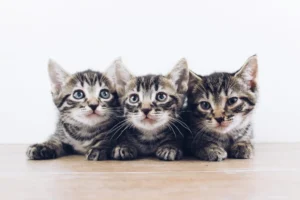Cats are often considered the perfect pet for children, bringing joy and companionship to families. But what exactly makes them such great companions for kids?
Low Maintenance Pets
Cats are low maintenance pets, which makes them a purrfect choice for busy families. Unlike dogs that require daily walks, cats are content with using a litter box. They groom themselves fastidiously, so you won’t need to bathe them often. Additionally, cats don’t need constant attention, making them ideal for families with hectic schedules. Just provide food, water, and a clean litter box, and your feline friend will be happy as a clam.
One unique benefit of having a cat is that they are adept at hunting pests like mice and bugs. This natural inclination can be a real lifesaver, especially if you live in an area prone to critter invasions. So, not only are cats low maintenance when it comes to care, but they can also help keep your home free of unwanted visitors.
Independent Nature
Cats’ independent nature can be a boon for teaching kids responsibility. While dogs may require constant supervision and attention, cats are more self-sufficient. Kids can learn the importance of routine by feeding their cat at the same time each day. They can also develop empathy by understanding a cat’s need for space and respecting their boundaries.
Moreover, cats’ ability to show affection on their own terms can teach kids valuable lessons in patience and understanding. By learning to interpret a cat’s body language and cues, children can build strong bonds based on trust and respect. This fosters a sense of companionship that is mutually beneficial for both the child and the cat.
Bonding Opportunities
Caring for a cat can lead to special bonding moments between kids and their furry companions. Feeding your cat together can teach children responsibility and create a sense of teamwork. Additionally, grooming sessions can serve as calm, focused times for interaction. Moreover, playtime activities like chasing a toy can strengthen the bond as kids and cats engage in shared fun.
Emotional Support
Cats can offer crucial emotional support to children, especially during challenging times. Studies have shown that interacting with a cat can reduce stress and anxiety levels in kids. When children are upset or feeling down, a cat’s comforting presence can provide solace and reassurance. Simply petting a cat can release feel-good hormones in both the child and the pet, fostering a sense of emotional connection. Listening to a cat’s purring can have a soothing effect on children, aiding in relaxation and emotional regulation.
Playful Companions
Cats are fantastic pets for kids because they make playful and engaging companions. With their energetic antics and curious personalities, cats provide endless entertainment for children. Whether chasing a toy or pouncing on imaginary prey, cats keep kids entertained for hours on end. Their playful nature encourages kids to be active and engaged, fostering a strong bond between them and their furry friend.
Educational Benefits
Caring for a cat offers a myriad of educational benefits for kids. Through the responsibility of feeding, grooming, and playing with their feline friend, children learn valuable lessons in empathy, compassion, and nurturing. They develop a sense of responsibility and empathy as they tend to the needs of their pet, teaching kids important life skills they can carry with them into adulthood. Additionally, caring for a cat can help children understand the importance of routine and consistency in caregiving.
Additional unique insight: Cats can also teach kids the importance of patience and understanding, as they learn to interpret their feline companion’s behaviors and emotions.
Health Benefits
Having a cat as a pet can bring numerous health benefits to both children and adults. Studies have shown that interacting with cats can reduce stress and anxiety levels. The gentle purring of a cat can have a calming effect on individuals, promoting relaxation and a sense of well-being.
Moreover, owning a cat can encourage kids to be more active. Playing with a cat, grooming them, or simply chasing after them can provide a fun way to incorporate physical activity into a child’s routine. This can help in promoting a healthy lifestyle and reducing the risk of obesity.
Cats are also known to have a therapeutic effect on their owners. The act of petting a cat can release endorphins in the brain, which are hormones that promote feelings of happiness and reduce pain. This can be particularly beneficial for children who may be experiencing emotional distress or discomfort.
Safety Considerations
When introducing a cat into a household with children, it is important to consider safety precautions to ensure a harmonious and safe environment for all. First and foremost, it is essential to teach children how to properly handle and interact with a cat. This includes gentle petting, avoiding tail pulling or ear grabbing, and respecting the cat’s personal space.
It is also crucial to supervise interactions between children and cats, especially for younger kids who may not understand boundaries. Cats, like all animals, may react unpredictably if they feel threatened or scared, so it is important to monitor their interactions closely to prevent any potential incidents.
Additionally, make sure to provide retreat spaces for the cat where they can escape to if they need a break from children’s play or noise. This can help reduce stress for the cat and create a more peaceful environment for everyone in the household.
Extra Tip: Consider adopting an older cat from a shelter, as they may be more tolerant and patient with children compared to kittens who may be more energetic and rambunctious.
Fun Facts About Cats
Did you know that cats have a special reflective layer behind their retinas that helps them see better in low light? This makes them excellent hunters, even in the dark! Cats can curl up into a tight ball to conserve body heat, which is why they love cozy spots. Another fun fact is that cats have a unique grooming behavior called “allogrooming,” where they groom each other as a form of social bonding. These fascinating facts can be great conversation starters for kids and parents alike, deepening their appreciation for their feline friends.
Creative Activities
Looking for ways to bond with your cat and create lasting memories? Try out these fun activities with your furry companion: – DIY Cat Toys: Get creative and make homemade toys like feather wands, cardboard boxes, or crinkle balls to keep your cat entertained. – Interactive Play: Engage in games like hide and seek, laser pointer chase, or puzzle feeders to stimulate your cat’s mind and strengthen your bond. – Cat Agility Course: Design a mini obstacle course with tunnels, hoops, and hurdles to challenge your cat’s agility and provide hours of fun. – Cat-Approved Treats: Bake cat-friendly treats together using simple recipes like tuna bites or catnip cookies, adding a delicious touch to your bonding sessions. – Cat Photography: Capture adorable moments with your cat by setting up a photoshoot with props and costumes for a fun and creative way to document your special bond.
These activities not only foster a deeper connection with your cat but also promote creativity, problem-solving skills, and a sense of companionship in children. Enjoy these special moments with your feline friend!
Alex, a passionate animal lover, has experience in training and understanding animal behavior. As a proud pet parent to two dogs and three cats, he founded AnimalReport.net to share insights from animal experts and expand his knowledge of the animal kingdom.









